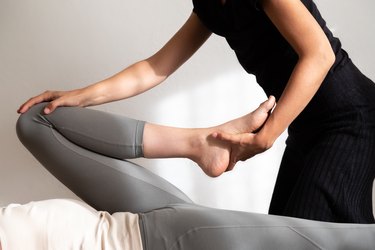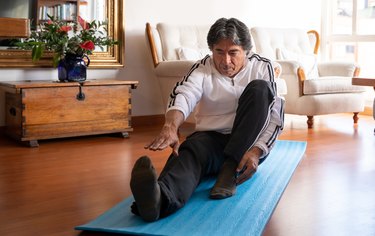
Physical therapy isn't just for after surgery, and it's not just for rehabilitation — those are some of the most common reasons for physical therapy, but in fact, a physical therapist can help you maintain (and improve) whole-body health.
"Everybody should have a physical therapist on hand, and treat it more like going to the dentist. Everybody has a dentist. You do your checkup every six months, get things cleaned up, and it's preventative care," says Renato Sanchez, DPT, CSCS, physical therapist at Bespoke Treatments in San Diego. "It's the same thing for physical therapy."
Video of the Day
Video of the Day
Instead of checking for cavities, though, physical therapists can make sure your movement is clean, he says. That will keep you up and at 'em, and away from injury. (And away from the PT office for non-preventative reasons.)
And with changes in insurance coverage that address wellness more than just sickness and injury, physical therapy is easier to access, with these types of visits often covered, says Scott Cheatham, PhD, DPT, a professor of kinesiology at California State University, Dominguez Hills, and a NASM-certified personal trainer.
"Traditionally in the U.S. healthcare system, physical therapy has always been looked at as post-surgical or post-injury rehabilitation," he says. "As we start getting more knowledge about the importance of regular exercise and lifestyle modification, the physical therapist has become a key healthcare provider, and a direct access provider for active individuals."
The term "direct access" means that patients can see a PT directly, without a referral, Cheatham says. Because of this, their offices are prepared for patients to call for reasons that aren't rehab.
When making an appointment for a movement checkup, some lingering pain or any of the other reasons below, Cheatham says, communicate your goals for seeing a PT, whether it's a pre-exercise screening, to address lingering injury, or one of the other reasons listed below.
Clear communication and goal setting will help the physical therapist be ready to assess your movement and provide corrective movements, exercises and strategies that can help.
Here are seven situations where a physical therapist (really, a movement specialist) can help improve your health and wellbeing.
1. Before Starting a New Exercise Program
Many workout programs and classes have a disclaimer that you should see a doctor before starting a new exercise program. A physician can help determine if you're healthy enough for that activity — if you're at risk for heart or lung problems as a result, for example.
But visiting a physical therapist before you start can help make sure you're ready from a movement perspective, Cheatham says.
"The physical therapist can screen for potential injuries. They can screen for flexibility, proper strength and the proper endurance to be able to work out," he says. "And then they can make recommendations for safe exercise."
Some patients, Sanchez says, fear that this kind of screen or visit will result in the PT telling the patient not to participate in the exercise, or that they need a long rehab process before they can. That's rarely the case.
"The worst thing I can tell someone is that they can't do the thing they want to do," he says. Instead, the PT may provide you with a few moves to do before your new activity — a short warmup or other movements that can help you participate with more confidence and a lower risk of injury.
2. You Have Pain From Exercise
When many people experience joint or muscle pain from a workout at the gym, a run or another type of workout, they have the same reaction, Sanchez says.
"They tend to just take a week or two off and think, 'I'll try again in a week or so,'" he says. "They'll completely stop whatever they were doing, whether it was a single movement, or training in general, and expect it will just get better."
Sometimes, this works. But the time off can also make you weaker in the surrounding muscles due to a lack of use, or the pain may not go away.
If you experience acute pain from an exercise, stop doing that exercise during that session, Renato says. If your back hurts from a deadlift, for example, don't keep deadlifting and make the injury worse. But instead of just laying off it for a week or two, consider seeing a PT right away.
"If you go to a PT right away, you'll end up with strategies [for overcoming the pain and moving better], instead of just guesswork," he says. You may actually need to take less time away from the exercise than you would by simply resting.
And if there's more to the injury than can just be fixed with PT, Cheatham says, the physical therapist will know, and will be able to refer you to a doctor for further examination.
3. You Can’t Perform a Movement You Used to Be Able To
If there's a movement you used to be able to do — at home or in your workouts — but you can't anymore, don't just chalk it up to aging, Sanchez says. And don't just "work around it."
"Any time there's a movement you used to do, and you feel like you have to modify it, or you're restricted in certain situations, you should go to PT," he says. "Physical therapists are movement specialists for a reason. So we would do an in-depth assessment to see what is going on, and then tell you to continue doing what it is you're doing, but with some tweaks."
For example, if a patient who loves to surf is having trouble with shoulder pain while paddling and has had to change their stroke, Sanchez says, he doesn't tell them to stop the activity they love. Instead, he might provide a short warmup routine that helps them move their shoulder in the way that it used to, as well as a daily five-minute routine that can help strengthen that movement pattern.
4. You Have Numbness or Tingling
Numbness or tingling can point to an injury at a nerve root, Sanchez says.
"If someone goes for a deadlift, and they wrench their back, they might have shooting, sharp pain down their leg, and they might lose some function of standing on their toes on one side," he says. "More than likely, there is an injury at a specific nerve root as it exits the spine."
This doesn't just happen with back injuries. Neck injuries can result in numbness in the arms and nerve pain in the shoulder, for example.
If you're feeling numbness or tingling in your extremities, consult a physical therapist and your doctor. The PT may be able to help improve movement patterns that are causing this nerve impingement.
5. You’re Losing Mobility and Flexibility
Spending lots of time in a chair can stiffen you up. This type of mobility and flexibility loss is in the scope of what a personal trainer can do, says Sanchez, who's both a physical therapist and a strength coach, working as a personal trainer.
But if you work with a personal trainer for a while, and nothing is really improving, you should seek out a physical therapist (and your trainer is likely to want to refer you to one).
That's because personal trainers and physical therapists are part of your personal healthcare ecosystem. In this universe of care, Cheatham says, different practitioners care for different parts of your health, and can help refer you to others for other portions. For example, your physical therapist may have a close relationship with a nutritionist or acupuncturist, if you need these types of services.
And a personal trainer most likely has a close relationship with a physical therapist they trust. So if you need a new part of your health ecosystem, don't just Google: Ask health practitioners you already trust for a recommendation.
6. Before and After Surgery
Physical therapy is often prescribed for after surgery to help patients recover faster and get back to moving in a normal way. If your surgery doesn't include PT, you can still consider it, Sanchez says. But he also suggests heading to a physical therapist before going under the knife.
"If someone tears their ACL [anterior cruciate ligament, one of the ligaments in the knee], they'll just stop completely. They'll say, 'I'll just start rehab after the surgery,'" he says. As a result, they stop moving all together. "All these things you've been training and training for, you're losing them. You don't have to."
Pre-surgery PT, he says, can also help strengthen and prepare your body in such a way that you'll recover faster when you do begin post-surgery rehab. Because the other movements and muscles that you can use before surgery stay strong, you won't have to re-strengthen them while you're rehabbing the repaired portion of your body.
7. Before and After Having a Baby
"If you've had a baby, you should definitely go see a PT," he says, to assess the function of your pelvic floor.
Post-natal incontinence, where women experience bladder issues when doing something strenuous, has become normalized, he says. But it doesn't have to be permanent. These troubles are often due to issues in the pelvic floor and the surrounding muscles, and a PT who specializes in post-natal or pelvic floor care can help.
Sanchez also suggests seeing a physical therapist who specializes in these areas before giving birth. As with surgery, seeing a physical therapist during the pre-natal period can help make mothers stronger for the process of giving birth.
"You're going to know how to move all your pelvic floor muscles, your diaphragm, your rectus abdominis, all of it," he says. You'll be able to breathe stronger and feel stronger through the process.


